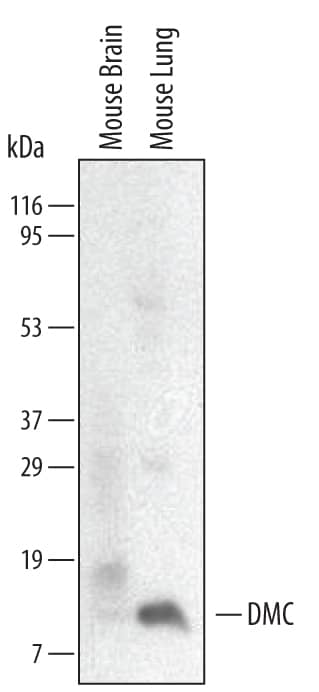Mouse CXCL17/VCC-1 Antibody
R&D Systems, part of Bio-Techne | Catalog # MAB4270

Key Product Details
Species Reactivity
Applications
Label
Antibody Source
Product Specifications
Immunogen
Ser31-Leu119
Accession # Q5UW37
Specificity
Clonality
Host
Isotype
Scientific Data Images for Mouse CXCL17/VCC-1 Antibody
Detection of Mouse CXCL17 by Western Blot.
Western blot shows lysates of mouse lung tissue. PVDF membrane was probed with 2 µg/mL of Rat Anti-Mouse CXCL17 Monoclonal Antibody (Catalog # MAB4270) followed by HRP-conjugated Anti-Rat IgG Secondary Antibody (Catalog # HAF005). A specific band was detected for CXCL17 at approximately 11 kDa (as indicated). This experiment was conducted under reducing conditions and using Immunoblot Buffer Group 1 (with 3% BSA instead of 5% milk in the Antibody Solution).Applications for Mouse CXCL17/VCC-1 Antibody
Western Blot
Sample: Mouse lung tissue
Formulation, Preparation, and Storage
Purification
Reconstitution
Formulation
Shipping
Stability & Storage
- 12 months from date of receipt, -20 to -70 °C as supplied.
- 1 month, 2 to 8 °C under sterile conditions after reconstitution.
- 6 months, -20 to -70 °C under sterile conditions after reconstitution.
Background: CXCL17/VCC-1
CXCL17, also known as dendritic cell and monocyte chemokine-like protein (DMC) and VEGF-correlated chemokine-1 (VCC-1), is a secreted molecule with a size and predicted three-dimensional folding pattern similar to that of chemokines CXCL8/IL-8 and CXCL14/BRAK (1, 2). It has no predicted N-glycosylation sites, so cleavage of a 22 amino acid (aa) signal sequence likely results in a mature mouse CXCL17 molecule of 97 aa and 11 kDa size. CXCL17 is constitutively produced by airway and intestinal epithelium (1). It induces the chemotaxis of quiescent, but not LPS‑activated peripheral blood monocytes and dendritic cells, and also binds these cells specifically (1). CXCL17 expression is increased in endothelial cells when they are induced to form tubes in vitro (2). Transgenic overexpression in NIH3T3 cells causes upregulation of proteins such as VEGF and FGF basic, and increases cell growth rate and tumorigenicity (2). CXCL17 and two other chemokines that play roles in angiogenesis, CXCL1/GRO and CXCL8/IL-8, show significantly correlated expression with that of VEGF in primary lung, breast and esophageal tumors (2). CXCL17 is therefore suggested to play a role in tumor angiogenesis. Mature mouse CXCL17 shares 82%, 71% and 66% amino acid sequence identity with rat, human and bovine CXCL17, respectively.
References
- Pisabarro, M. T. et al. (2006) J. Immunol. 176:2069.
- Weinstein, E. J. et al. (2006) Biochem. Biophys. Res. Commun. 350:74.
Alternate Names
Gene Symbol
UniProt
Additional CXCL17/VCC-1 Products
Product Documents for Mouse CXCL17/VCC-1 Antibody
Product Specific Notices for Mouse CXCL17/VCC-1 Antibody
For research use only
